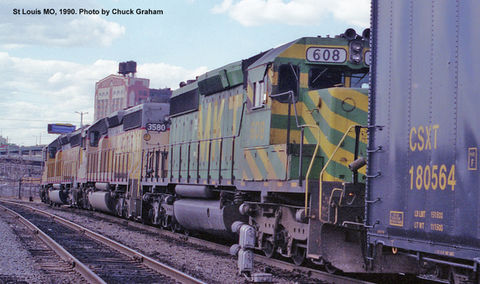The upper level of my two-level layout is all narrow gauge, depicting a portion of the former Denver & Rio Grande Western’s Fourth Division line in southwestern Colorado and northern New Mexico.
St Louis MO
One normally thinks of Chicago as the great interchange point between eastern and western railroads. St Louis is also a great interchange point, but split by the Mississippi River. In the 1970s, eight of the major eastern roads had terminals on the “east side” in the East St Louis Illinois area, four of the major western roads terminated on the west side in St Louis, and several transfer short lines provided interchange between the majors. When a new job brought me to the area in the late 1970s, there was lots to see, but starting a career and raising a young family took precedence over railfanning for quite a while. Here are some vignettes from those days.
Downtown St Louis – Gratiot Tower
Gratiot Tower stood in downtown St Louis, at the western approach of the MacArthur (or Municipal) Bridge across the Mississippi River, and just east of St Louis Union Station. It was a place of frequent action, at the junction of Terminal Railway Association of St Louis (TRRA)’s Merchants Sub (which passes by the Gateway Arch) and the MacArthur Bridge Sub, and Union Pacific’s 23rd Street yard to the west and UP’s L’Esperance yard to the southeast. These photos were taken while my friend Larry was visiting in March, 1990.
Click on each image for caption with more info
St Louis Area – West
These are photos taken in a few locations in west St Louis County in the late 1970s to 1980.
Click on each image for caption with more info
The merger mania which took over the US railroads impacted all the lines in the western St Louis area: The Frisco was merged into the Burlington Northern in 1980, and later into the Burlington Northern Santa Fe (BNSF) in 1995; the Missouri Pacific and the Katy were taken over by Union Pacific in 1982 and 1988; and the Norfolk and Western (Wabash) was merged into the Norfolk Southern in 1990. However, most of the lines have remained intact and are active to this day.
References: A great resource for railfanning in the St Louis area is the Train Watcher’s Guide to St Louis, by John Szwajkart (1983). A thorough history of the MacArthur Bridge in downtown St Louis is The St. Louis Municipal Bridge Railway, published by the Terminal Railway Association of St. Louis Historical and Technical Society, Inc, Issue 65 (summer 2005).

















